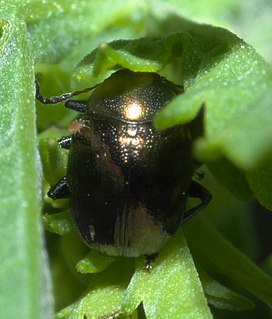
The Fulcidacini are a tribe within the leaf beetle subfamily Cryptocephalinae, though historically they were often treated as a distinct subfamily, Chlamisinae. 11 genera with altogether about 400 species are currently placed here; some four-fifths of the species are found in the Neotropics, but the rest is distributed over all other continents except Antarctica.

The Lamprosomatinae are a small subfamily of leaf beetles (Chrysomelidae). They belong to the case-bearing Camptosomata.

Syneta is a genus of leaf beetles in the subfamily Synetinae. There are about 11 described species in Syneta. The genus is entirely holarctic in distribution, with species appearing in North America, Siberia, East Asia and Northern Europe.

Calligrapha is a genus of large American Chrysomelinae of imprecise taxonomic boundaries. Most species occur in Central and South America.

Chalepini is a tribe of leaf beetles in the family Chrysomelidae. There are at least 50 genera and 830 described species in Chalepini.
Stenispa is a genus of tortoise beetles and hispines in the family Chrysomelidae. There are at least 20 described species in Stenispa.
Jonthonota is a genus of tortoise beetles in the family Chrysomelidae. There are at least two described species in Jonthonota.

Eumolpini is a tribe of leaf beetles in the subfamily Eumolpinae. It is the largest tribe in the subfamily, with approximately 170 genera found worldwide. Members of the tribe almost always have a longitudinal median groove on the pygidium, which possibly helps to keep the elytra locked at rest. They also generally have a subglabrous body, as well as appendiculate pretarsal claws.
Anisostena is a genus of tortoise beetles and hispines in the family Chrysomelidae. There are at least 30 described species in Anisostena.

Odontota is a genus of tortoise beetles and hispines in the family Chrysomelidae. There are about nine described species in Odontota.
Urodera is a genus of case-bearing leaf beetles in the family Chrysomelidae. There are about nine described species in Urodera.
Pteleon is a genus of leaf beetles in the family Chrysomelidae. There are at least three described species in Pteleon.
Neltumius is a genus of pea and bean weevils in the beetle family Chrysomelidae. There are at least three described species in Neltumius.

Oomorphus is a genus of leaf beetles in the family Chrysomelidae. There are about 18 described species in Oomorphus.
Janbechynea is a genus of leaf beetles in the family Orsodacnidae. There are at least 12 described species in Janbechynea, found in North America. The genus is named after the Czech entomologist Jan Bechyně.
Metaparia is a genus of leaf beetles in the subfamily Eumolpinae. There are nine described species in Metaparia, from North America and Central America.

Typophorini is a tribe of leaf beetles in the subfamily Eumolpinae. The tribe contains approximately 100 genera, which are found worldwide. Members of the tribe are mainly characterized by notches on the tibiae of the middle and hind legs, which are sometimes referred to as antenna cleaners. They also generally have a subglabrous body, as well as bifid pretarsal claws.
Octotoma is a genus of tortoise beetles and hispines in the family Chrysomelidae. There are about 12 described species in Octotoma.
Cubispa is a genus of leaf beetles consisting of two species from Central America and the Caribbean. It is classified within the tribe Cubispini, which is placed within either the Eumolpinae or the Cassidinae. Beetles in the genus are wingless, and are associated with cloud forests.
Cubispini is a tribe of leaf beetles from the Neotropical realm. It is classified within either the Eumolpinae or the Cassidinae. It was established by Francisco Monrós in 1954 to contain the genus Cubispa, which was originally placed in the subfamily Hispinae, in the tribe Cephaloleini. A second genus, Lobispa, was described and placed in the tribe by C.L. Staines in 2001.







